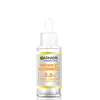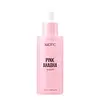What's inside
What's inside
 Key Ingredients
Key Ingredients

 Benefits
Benefits

 Concerns
Concerns

 Ingredients Side-by-side
Ingredients Side-by-side

Water
Skin ConditioningGlycerin
HumectantAlcohol
AntimicrobialDipropylene Glycol
HumectantButylene Glycol
HumectantNiacinamide
SmoothingPEG/PPG/Polybutylene Glycol-8/5/3 Glycerin
HumectantCeramide AP
Skin ConditioningHydroxyethylpiperazine Ethane Sulfonic Acid
BufferingBis-PEG-18 Methyl Ether Dimethyl Silane
EmollientIsononyl Isononanoate
Emollient3-O-Ethyl Ascorbic Acid
Skin ConditioningCitrus Junos Fruit Extract
Skin ConditioningCitrus Limon Fruit Extract
MaskingSodium Citrate
BufferingSodium Hyaluronate
HumectantAdenosine
Skin ConditioningPhenylethyl Resorcinol
AntioxidantAmmonium Polyacryloyldimethyl Taurate
Emulsion StabilisingDisodium EDTA
Hydrogenated Lecithin
EmulsifyingCitric Acid
BufferingMaltodextrin
AbsorbentXanthan Gum
EmulsifyingOxothiazolidinecarboxylic Acid
Skin ConditioningTocopherol
AntioxidantTocopheryl Acetate
AntioxidantSalicylic Acid
MaskingPhenoxyethanol
PreservativeLinalool
PerfumingGeraniol
PerfumingLimonene
PerfumingBenzyl Alcohol
PerfumingBenzyl Salicylate
PerfumingParfum
MaskingWater, Glycerin, Alcohol, Dipropylene Glycol, Butylene Glycol, Niacinamide, PEG/PPG/Polybutylene Glycol-8/5/3 Glycerin, Ceramide AP, Hydroxyethylpiperazine Ethane Sulfonic Acid, Bis-PEG-18 Methyl Ether Dimethyl Silane, Isononyl Isononanoate, 3-O-Ethyl Ascorbic Acid, Citrus Junos Fruit Extract, Citrus Limon Fruit Extract, Sodium Citrate, Sodium Hyaluronate, Adenosine, Phenylethyl Resorcinol, Ammonium Polyacryloyldimethyl Taurate, Disodium EDTA, Hydrogenated Lecithin, Citric Acid, Maltodextrin, Xanthan Gum, Oxothiazolidinecarboxylic Acid, Tocopherol, Tocopheryl Acetate, Salicylic Acid, Phenoxyethanol, Linalool, Geraniol, Limonene, Benzyl Alcohol, Benzyl Salicylate, Parfum
Citrullus Lanatus Fruit Extract
Skin ConditioningButylene Glycol
HumectantDipropylene Glycol
HumectantGlycereth-26
HumectantGlycerin
Humectant1,2-Hexanediol
Skin ConditioningIsopentyldiol
HumectantNiacinamide
SmoothingAmmonium Acryloyldimethyltaurate/Vp Copolymer
Water
Skin ConditioningPanthenol
Skin ConditioningPropanediol
SolventPolyglyceryl-10 Laurate
Skin ConditioningDipotassium Glycyrrhizate
HumectantAllantoin
Skin ConditioningEthylhexylglycerin
Skin ConditioningLavandula Angustifolia Oil
MaskingAdenosine
Skin ConditioningCarbomer
Emulsion StabilisingTromethamine
BufferingDisodium EDTA
Diphenyl Dimethicone
EmollientTriethylhexanoin
MaskingSalicylic Acid
MaskingCitric Acid
BufferingPolyglyceryl-10 Oleate
Skin ConditioningHydrogenated Lecithin
EmulsifyingSodium Hyaluronate
HumectantGardenia Florida Fruit Extract
Skin ConditioningCyanocobalamin
Skin ConditioningDextrin
AbsorbentTranexamic Acid
AstringentGlutathione
Calamine
AbsorbentSodium Ascorbyl Phosphate
AntioxidantMelaleuca Alternifolia Leaf Extract
PerfumingLactobacillus/Soybean Ferment Extract
Skin ConditioningSodium Hyaluronate Crosspolymer
HumectantHydrolyzed Glycosaminoglycans
HumectantDioscorea Japonica Root Extract
Skin ConditioningTremella Fuciformis Extract
HumectantHippophae Rhamnoides Fruit Extract
Skin ConditioningBenzyl Glycol
SolventCentella Asiatica Extract
CleansingHydrolyzed Hyaluronic Acid
HumectantHyaluronic Acid
HumectantRaspberry Ketone
MaskingLimonene
PerfumingLinalool
PerfumingCitrullus Lanatus Fruit Extract, Butylene Glycol, Dipropylene Glycol, Glycereth-26, Glycerin, 1,2-Hexanediol, Isopentyldiol, Niacinamide, Ammonium Acryloyldimethyltaurate/Vp Copolymer, Water, Panthenol, Propanediol, Polyglyceryl-10 Laurate, Dipotassium Glycyrrhizate, Allantoin, Ethylhexylglycerin, Lavandula Angustifolia Oil, Adenosine, Carbomer, Tromethamine, Disodium EDTA, Diphenyl Dimethicone, Triethylhexanoin, Salicylic Acid, Citric Acid, Polyglyceryl-10 Oleate, Hydrogenated Lecithin, Sodium Hyaluronate, Gardenia Florida Fruit Extract, Cyanocobalamin, Dextrin, Tranexamic Acid, Glutathione, Calamine, Sodium Ascorbyl Phosphate, Melaleuca Alternifolia Leaf Extract, Lactobacillus/Soybean Ferment Extract, Sodium Hyaluronate Crosspolymer, Hydrolyzed Glycosaminoglycans, Dioscorea Japonica Root Extract, Tremella Fuciformis Extract, Hippophae Rhamnoides Fruit Extract, Benzyl Glycol, Centella Asiatica Extract, Hydrolyzed Hyaluronic Acid, Hyaluronic Acid, Raspberry Ketone, Limonene, Linalool
 Reviews
Reviews

Ingredients Explained
These ingredients are found in both products.
Ingredients higher up in an ingredient list are typically present in a larger amount.
Adenosine is in every living organism. It is one of four components in nucleic acids that helps store our DNA.
Adenosine has many benefits when used. These benefits include hydrating the skin, smoothing skin, and reducing wrinkles. Once applied, adenosine increases collagen production. It also helps with improving firmness and tissue repair.
Studies have found adenosine may also help with wound healing.
In skincare products, Adenosine is usually derived from yeast.
Learn more about AdenosineButylene Glycol (or BG) is used within cosmetic products for a few different reasons:
Overall, Butylene Glycol is a safe and well-rounded ingredient that works well with other ingredients.
Though this ingredient works well with most skin types, some people with sensitive skin may experience a reaction such as allergic rashes, closed comedones, or itchiness.
Learn more about Butylene GlycolCitric Acid is an alpha hydroxy acid (AHA) naturally found in citrus fruits like oranges, lemons, and limes.
Like other AHAs, citric acid can exfoliate skin by breaking down the bonds that hold dead skin cells together. This helps reveal smoother and brighter skin underneath.
However, this exfoliating effect only happens at high concentrations (20%) which can be hard to find in cosmetic products.
Due to this, citric acid is usually included in small amounts as a pH adjuster. This helps keep products slightly more acidic and compatible with skin's natural pH.
In skincare formulas, citric acid can:
While it can provide some skin benefits, research shows lactic acid and glycolic acid are generally more effective and less irritating exfoliants.
Most citric acid used in skincare today is made by fermenting sugars (usually from molasses). This synthetic version is identical to the natural citrus form but easier to stabilize and use in formulations.
Read more about some other popular AHA's here:
Learn more about Citric AcidDipropylene Glycol is a synthetically created humectant, stabilizer, and solvent.
This ingredient helps:
Dipropylene glycol is technically an alcohol, but it belongs to the glycol family (often considered part of the ‘good’ alcohols). This means it is hydrating and gentle on skin unlike drying solvent alcohols like denatured alcohol.
As a masking agent, Dipropylene Glycol can be used to cover the smell of other ingredients. However, it does not have a scent.
Studies show Dipropylene Glycol is considered safe to use in skincare.
Learn more about Dipropylene GlycolDisodium EDTA plays a role in making products more stable by aiding other preservatives.
It is a chelating agent, meaning it neutralizes metal ions that may be found in a product.
Disodium EDTA is a salt of edetic acid and is found to be safe in cosmetic ingredients.
Learn more about Disodium EDTAGlycerin is already naturally found in your skin. It helps moisturize and protect your skin.
A study from 2016 found glycerin to be more effective as a humectant than AHAs and hyaluronic acid.
As a humectant, it helps the skin stay hydrated by pulling moisture to your skin. The low molecular weight of glycerin allows it to pull moisture into the deeper layers of your skin.
Hydrated skin improves your skin barrier; Your skin barrier helps protect against irritants and bacteria.
Glycerin has also been found to have antimicrobial and antiviral properties. Due to these properties, glycerin is often used in wound and burn treatments.
In cosmetics, glycerin is usually derived from plants such as soybean or palm. However, it can also be sourced from animals, such as tallow or animal fat.
This ingredient is organic, colorless, odorless, and non-toxic.
Glycerin is the name for this ingredient in American English. British English uses Glycerol/Glycerine.
Learn more about GlycerinHydrogenated Lecithin is created from the hydrogenation of lecithin (a group of phospholipids). Hydrogenation is a chemical reaction between hydrogen and another element.
This ingredient is an emollient and emulsifier. As an emollient, it helps soften skin by trapping moisture within. As an emulsifier, it prevents oil and water ingredients from separating.
Limonene is a fragrance that adds scent and taste to a formulation.
It's found in the peel oil of citrus fruits and other plants such as lavender and eucalyptus. The scent of limonene is generally described as "sweet citrus".
Limonene acts as an antioxidant, meaning it helps neutralize free radicals.
When exposed to air, oxidized limonene may sensitize the skin. Because of this, limonene is often avoided by people with sensitive skin.
The term 'fragrance' is not regulated in many countries. In many cases, it is up to the brand to define this term. For instance, many brands choose to label themselves as "fragrance-free" because they are not using synthetic fragrances. However, their products may still contain ingredients such as essential oils that are considered a fragrance.
Learn more about LimoneneLinalool is a fragrance and helps add scent to products. It's derived from common plants such as cinnamon, mint, citrus, and lavender.
Like Limonene, this ingredient oxidizes when exposed to air. Oxidized linalool can cause allergies and skin sensitivity.
This ingredient has a scent that is floral, spicy tropical, and citrus-like.
Learn more about LinaloolNiacinamide is a multitasking form of vitamin B3 that strengthens the skin barrier, reduces pores and dark spots, regulates oil, and improves signs of aging.
And the best part? It's gentle and well-tolerated by most skin types, including sensitive and reactive skin.
You might have heard of "niacin flush", or the reddening of skin that causes itchiness. Niacinamide has not been found to cause this.
In very rare cases, some individuals may not be able to tolerate niacinamide at all or experience an allergic reaction to it.
If you are experiencing flaking, irritation, and dryness with this ingredient, be sure to double check all your products as this ingredient can be found in all categories of skincare.
When incorporating niacinamide into your routine, look out for concentration amounts. Typically, 5% niacinamide provides benefits such as fading dark spots. However, if you have sensitive skin, it is better to begin with a smaller concentration.
When you apply niacinamide to your skin, your body converts it into nicotinamide adenine dinucleotide (NAD). NAD is an essential coenzyme that is already found in your cells as "fuel" and powers countless biological processes.
In your skin, NAD helps repair cell damage, produce new healthy cells, support collagen production, strengthen the skin barrier, and fight environmental stressors (like UV and pollution).
Our natural NAD levels start to decline with age, leading to slower skin repair, visible aging, and a weaker skin barrier. By providing your skin niacinamide, you're recharging your skin's NAD levels. This leads to stronger, healthier, and younger looking skin.
Another name for vitamin B3 is nicotinamide. This vitamin is water-soluble and our bodies don't store it. We obtain Vitamin B3 from either food or skincare. Meat, fish, wheat, yeast, and leafy greens contain vitamin B3.
The type of niacinamide used in skincare is synthetically created.
Learn more about NiacinamideSalicylic Acid (also known as beta hydroxy acid or BHA) is a well-known ingredient for treating skin that struggles with acne and clogged pores. It exfoliates both the skin's surface and deep within the pores to help clear out buildup, control oil, and reduce inflammation.
Unlike AHAs (alpha hydroxy acids), salicylic acid is oil-soluble. This allows it to penetrate into pores which makes it especially effective for treating blackheads and preventing future breakouts.
Salicylic acid is also known for its soothing properties. It has a similar structure to aspirin and can calm inflamed or irritated skin, making it a good option for acne-prone skin that is also sensitive.
Concentrations of 0.5-2% are recognized by the U.S. FDA as an over-the-counter topical acne product.
It can cause irritation and/or dryness if one's skin already has a compromised moisture barrier, so it's best to focus on repairing that before introducing this ingredient into your routine.
While salicylic acid does not increase sun sensitivity, it’s still important to wear sunscreen daily to protect your skin.
If you are looking for the ingredient called BHA or Butylated Hydroxyanisole, click here.
Learn more about Salicylic AcidSodium Hyaluronate is hyaluronic acid's salt form. It is commonly derived from the sodium salt of hyaluronic acid.
Like hyaluronic acid, it is great at holding water and acts as a humectant. This makes it a great skin hydrating ingredient.
Sodium Hyaluronate is naturally occurring in our bodies and is mostly found in eye fluid and joints.
These are some other common types of Hyaluronic Acid:
Learn more about Sodium HyaluronateWater. It's the most common cosmetic ingredient of all. You'll usually see it at the top of ingredient lists, meaning that it makes up the largest part of the product.
So why is it so popular? Water most often acts as a solvent - this means that it helps dissolve other ingredients into the formulation.
You'll also recognize water as that liquid we all need to stay alive. If you see this, drink a glass of water. Stay hydrated!
Learn more about Water